抽象名词的译法
- 格式:pptx
- 大小:347.32 KB
- 文档页数:9
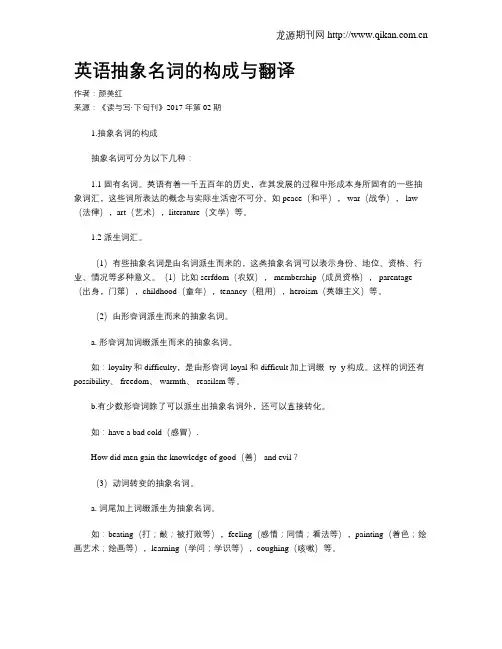
英语抽象名词的构成与翻译作者:颜美红来源:《读与写·下旬刊》2017年第02期1.抽象名词的构成抽象名词可分为以下几种:1.1 固有名词。
英语有着一千五百年的历史,在其发展的过程中形成本身所固有的一些抽象词汇,这些词所表达的概念与实际生活密不可分。
如peace(和平), war(战争), law (法律),art(艺术),literature(文学)等。
1.2 派生词汇。
(1)有些抽象名词是由名词派生而来的,这类抽象名词可以表示身份、地位、资格、行业、情况等多种意义。
(1)比如serfdom(农奴), membership(成员资格), parentage (出身,门第),childhood(童年),tenancy(租用),heroism(英雄主义)等。
(2)由形容词派生而来的抽象名词。
a. 形容词加词缀派生而来的抽象名词。
如:loyalty和 difficulty,是由形容词loyal 和difficult加上词缀 -ty -y构成。
这样的词还有possibility、 freedom、 warmth、 reasilsm等。
b.有少数形容词除了可以派生出抽象名词外,还可以直接转化。
如:have a bad cold(感冒).How did men gain the knowledge of good(善) and evil?(3)动词转变的抽象名词。
a. 词尾加上词缀派生为抽象名词。
如:beating(打;敲;被打败等),feeling(感情;同情;看法等),painting(着色;绘画艺术;绘画等),learning(学问;学识等),coughing(咳嗽)等。
b. 还有一类抽象名词是由相应的动词不经过派生直接转变而来的,不仅发生了功能的转移,意义也发生了变化。
如: What make of car did you buy?A man of his make is rare.Make 分别表示"牌子"和"性格"。

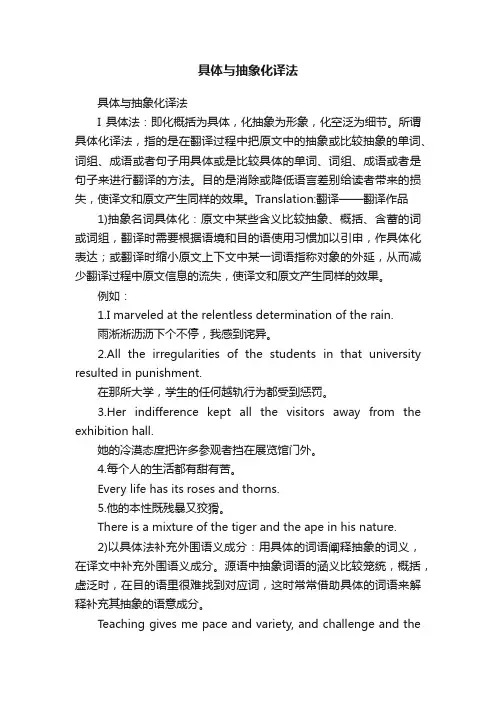
具体与抽象化译法具体与抽象化译法I具体法:即化概括为具体,化抽象为形象,化空泛为细节。
所谓具体化译法,指的是在翻译过程中把原文中的抽象或比较抽象的单词、词组、成语或者句子用具体或是比较具体的单词、词组、成语或者是句子来进行翻译的方法。
目的是消除或降低语言差别给读者带来的损失,使译文和原文产生同样的效果。
Translation:翻译——翻译作品1)抽象名词具体化:原文中某些含义比较抽象、概括、含蓄的词或词组,翻译时需要根据语境和目的语使用习惯加以引申,作具体化表达;或翻译时缩小原文上下文中某一词语指称对象的外延,从而减少翻译过程中原文信息的流失,使译文和原文产生同样的效果。
例如:1.I marveled at the relentless determination of the rain.雨淅淅沥沥下个不停,我感到诧异。
2.All the irregularities of the students in that university resulted in punishment.在那所大学,学生的任何越轨行为都受到惩罚。
3.Her indifference kept all the visitors away from the exhibition hall.她的冷漠态度把许多参观者挡在展览馆门外。
4.每个人的生活都有甜有苦。
Every life has its roses and thorns.5.他的本性既残暴又狡猾。
There is a mixture of the tiger and the ape in his nature.2)以具体法补充外围语义成分:用具体的词语阐释抽象的词义,在译文中补充外围语义成分。
源语中抽象词语的涵义比较笼统,概括,虚泛时,在目的语里很难找到对应词,这时常常借助具体的词语来解释补充其抽象的语意成分。
Teaching gives me pace and variety, and challenge and theopportunity to keep on learning.从事教学使我的工作进程有了规律,使我的生活变得丰富多彩,既向我提出了挑战,也为我提供了不断学习的机会。



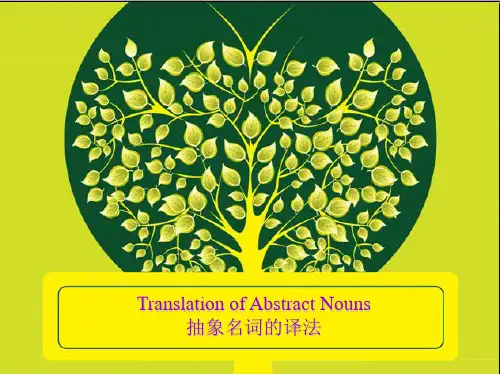


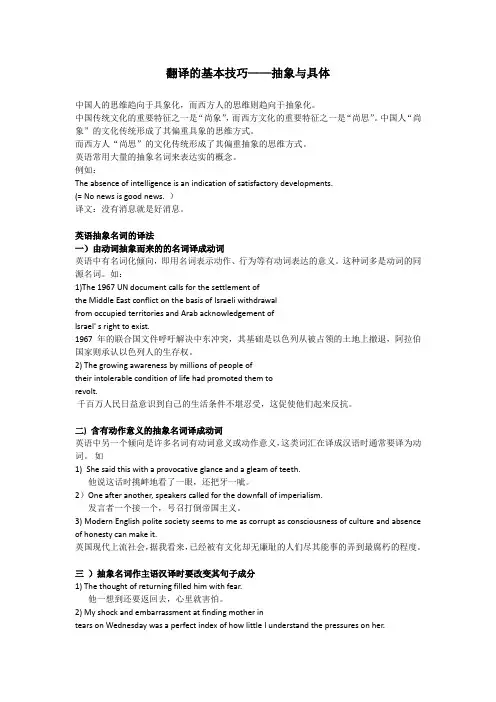
翻译的基本技巧——抽象与具体中国人的思维趋向于具象化,而西方人的思维则趋向于抽象化。
中国传统文化的重要特征之一是“尚象”,而西方文化的重要特征之一是“尚思”。
中国人“尚象”的文化传统形成了其偏重具象的思维方式。
而西方人“尚思”的文化传统形成了其偏重抽象的思维方式。
英语常用大量的抽象名词来表达实的概念。
例如:The absence of intelligence is an indication of satisfactory developments.(= No news is good news. )译文:没有消息就是好消息。
英语抽象名词的译法一)由动词抽象而来的的名词译成动词英语中有名词化倾向,即用名词表示动作、行为等有动词表达的意义。
这种词多是动词的同源名词。
如:1)The 1967 UN document calls for the settlement ofthe Middle East conflict on the basis of Israeli withdrawalfrom occupied territories and Arab acknowledgement ofIsrael' s right to exist.1967年的联合国文件呼吁解决中东冲突,其基础是以色列从被占领的土地上撤退,阿拉伯国家则承认以色列人的生存权。
2) The growing awareness by millions of people oftheir intolerable condition of life had promoted them torevolt.千百万人民日益意识到自己的生活条件不堪忍受,这促使他们起来反抗。
二) 含有动作意义的抽象名词译成动词英语中另一个倾向是许多名词有动词意义或动作意义,这类词汇在译成汉语时通常要译为动词。
如1) She said this with a provocative glance and a gleam of teeth.他说这话时挑衅地看了一眼,还把牙一呲。
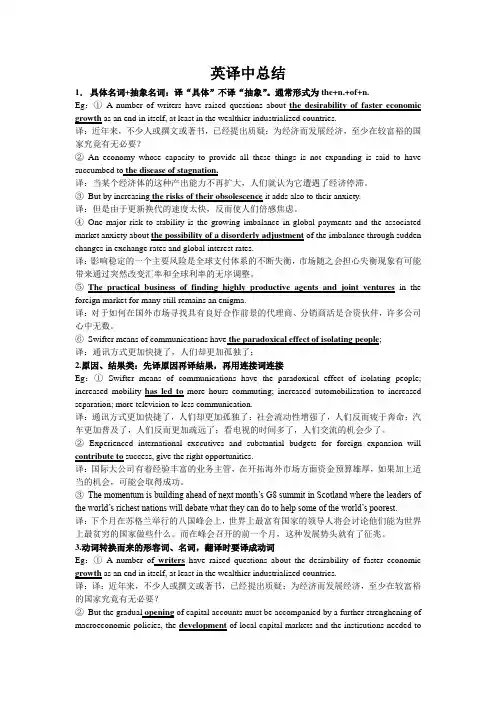
英译中总结1.具体名词+抽象名词:译“具体”不译“抽象”。
通常形式为the+n.+of+n.Eg:①A number of writers have raised questions the desirability of faster economic growth as an end in itself, at least in the wealthier industrialized countries.译:近年来,不少人或撰文或著书,已经提出质疑:为经济而发展经济,至少在较富裕的国家究竟有无必要?②An economy whose capacity to provide all these things is not expanding is said to have succumbed to the disease of stagnation.译:当某个经济体的这种产出能力不再扩大,人们就认为它遭遇了经济停滞。
③But by increasing the risks of their obsolescence it adds also to their anxiety.译:但是由于更新换代的速度太快,反而使人们倍感焦虑。
④One major risk to stability is the growing imbalance in global payments and the associated market anxiety about the possibility of a disorderly adjustment of the imbalance through sudden changes in exchange rates and global interest rates.译:影响稳定的一个主要风险是全球支付体系的不断失衡,市场随之会担心失衡现象有可能带来通过突然改变汇率和全球利率的无序调整。
英语中习惯用抽象概念表达具体的事物,抽象思维较突出;而汉语中更习惯运用形象的方法表达抽象的概念。
这经常表现为英语常常使用抽象名词来表达答复杂的理性概念,而汉语会用解释性或描述性较强的词语来表述抽象的意义。
抽象名词的翻译方法有以下几种:1. 直接翻译成汉语中对等的抽象名词由于英汉两种语言中都有抽象名词(当然,较之英语,汉语中的抽象名词要少得多),因此可以直接将英语中的抽象名词翻译成汉语中的抽象名词)。
例如:If he had the courage,he would go to the police station and re- port the whole case.如果他有勇气的话,他就会去警察局报案。
2. 转化词类a.英语中某些由形容词转化来的抽象名词可以直接转译成形容词,比较符合汉语的表达习惯。
例如:If one considers the enormous variety of courses offered,it is not hard to see how difficult it is for a student to select the course most suited to his interests and abilities.如果想一想那些设置的种类繁多的课程,我们不难发现,学生要选一门符合自己兴趣和能力的课程是多么困难。
The hard facts have shown the objectivity and correctness of the report.铁一般的事实证明了这一报告是客观而正确的。
b.有动作意味的抽象名词及某些由动词转化来的抽象名词可以转译成动词,表意更清楚。
例如:The sight and sound of our jet planes fitted me with special longing.看到我们的喷气式飞机,听见隆隆的声音,令我特别神往。
考研英语英译汉翻译技巧(3)抽象名词的翻译•相关推荐考研英语英译汉翻译技巧(3)抽象名词的翻译考生在做考研英语英译汉题目时,应首先把这篇四百字左右的短文当作泛读题看一遍,主要是对全文的大意、段落之间的关系有所了解。
在不影响对文章主旨的理解的情况下,若有不懂的句子大可不必在意。
下一步考生可以逐句地对五个划线部分的句子精读一番,下面是抽象名词的翻译方法。
科技英语中有名词化的倾向。
这其中包括一些由动词变过来的动作名词和动名词,如examination,examing。
这样的抽象名词本身就含有很强的动词意味,故在翻译的时候经常转译成动词。
此外,还有一些是形容词加后缀-ity,- ness, -ability构成的名词,翻译的'时候可以灵活译成相应的动词、状语(从句)、分句、意合句等等。
We were caught up in a discussion about the situation in Afghanistan when the professor walked into the classroom.译文:当教授走进教室时,我们正在兴致勃勃地讨论阿富汗局势。
It would be wise to handle this delicate problem with calmness and patience.译文:冷静耐心地处理这个微妙的问题是明智的。
Even an elementary knowledge of statistics is sufficient to enable the journalist to avoid misleading his readers.译文:即使只懂得一点统计学的初步知识,也足以使记者避免报道失真。
(名词词组译成状语从句)。
2021考研:英语抽象名词的翻译方式考研英语抽象名词如何着手翻译,还不知道的考生看过来,下面由小编为你精心准备了“2021考研:英语抽象名词的翻译方式”,持续关注本站将可以持续获取更多的考试资讯!2021考研:英语抽象名词的翻译方式例1 (2019 年英语1)Attempts have been made to curb this tendency, for example, by trying to incorporate some measure of quality as well as quantity into the assessment of an applicant’s papers.译文:人们已经做了许多尝试来遏制这种趋势,例如评估申请人的论文时,除了数量层面的考量,还尝试把质量标准纳入进来。
例1中“assessment”从动词“assess”派生出来的抽象名词,表示“评估,评价”。
但是如果直接翻译成名词,即“尝试将一些质量和数量的衡量标准纳入申请者论文的评估之中”会显得整个句子过于复杂。
因此译文将抽象名词翻译成动词“评估”,然后把例文中“trying to incorporate some measure of quality as well as quantity into the assessment of an applicant’s papers”部分分割成运用三个小短句,更符合中文表达特点和习惯。
例2(2018年英语一)By the date of his birth, Europe was witnessing the passing of the religious drama, and the creation of new forms under the incentive of classical tragedy and comedy.译文:他出生的时代,正值宗教剧在欧洲式微,受古典悲喜剧启发的崭新戏剧形式正在诞生。